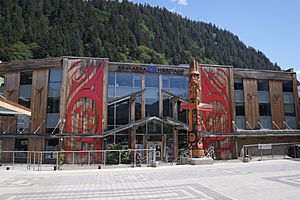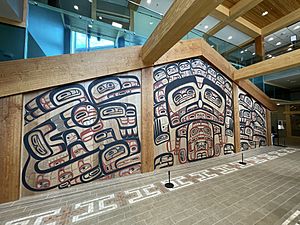Sealaska Corporation facts for kids
Sealaska Corporation is a company created to help Alaska Natives in Southeast Alaska. It was formed under a special law called the Alaska Native Claims Settlement Act (ANCSA) in 1971. This law settled land claims for Native people in Alaska.
Sealaska's main office is in Juneau, Alaska. It is a for-profit company, which means it aims to make money. It has over 23,000 shareholders, who are mostly Tlingit, Haida, and Tsimshian people.
Sealaska was officially started on June 16, 1972. Later, in 1981, Sealaska helped create a non-profit group called the Sealaska Heritage Institute. This institute focuses on cultural and educational programs for the community.
Sealaska makes money from natural resources, managing land, environmental services, and seafood.
Contents
When Sealaska first started, about 15,782 Alaska Natives became shareholders. Each person received 100 shares of Sealaska stock. Since then, about 1,800 more Alaska Natives have received shares through family inheritance or as gifts.
Unlike regular company stocks, Sealaska shares cannot be sold to the public. This is because Sealaska is an ANCSA corporation.
In 2007, Sealaska shareholders voted to allow descendants of the original shareholders to receive shares. These new shares last for the descendant's lifetime but cannot be passed on to others. To get these shares, descendants must be children or grandchildren of original shareholders. They also need to be at least one-quarter Alaska Native and not already a member of another regional corporation. Sealaska is one of the few ANCSA corporations that has given shares to descendants.
Sealaska has a special fund called the Permanent Fund. This fund invests in stocks, bonds, and real estate. It helps provide money for shareholders.
Sealaska also uses a lot of its earnings to help its communities. It offers many programs for young shareholders. These include scholarships for students, camps focused on wellness and culture, summer internships, and a special role for a young person on the company's board.
Sealaska's Lands
Sealaska owns about 290,000 acres (1,174 km2) of surface land in Southeast Alaska. This means they own the land on top. They also own about 560,000 acres (2,266 km2) of subsurface land. This means they own the resources underneath the land.
Even though Sealaska has the most shareholders of any regional corporation, it received the smallest amount of land. The original land settlement was 44 million acres. Sealaska later received an additional 65,000 acres of land. This happened because people in Congress supported their cause.
Sealaska's current land is only about 1.6 percent of the traditional homelands. The Tlingit, Haida, and Tsimshian people lived on these lands for over 10,000 years. Five traditional communities were not included in the original land transfer. Sealaska is working to get these communities the land they are owed.
What Sealaska Does for Business
Sealaska's main ways of making money are through natural resources, managing land, providing environmental services, and selling seafood.
Sealaska Heritage Institute
The Sealaska Heritage Institute is a non-profit group. It was started in 1980 by Sealaska. Clan leaders, traditional scholars, and elders first thought of the idea. The institute works to keep the Tlingit, Haida, and Tsimshian cultures of Southeast Alaska strong.
They do this through many programs and services. These include bringing languages back to life and keeping old cultural materials safe. They also have programs for young children to learn to read. They offer art classes and classes on how to live off the land. The institute also researches the history and culture of Alaska Natives.
In June 2022, during the Celebration festival in Juneau, Alaska, the Sealaska Heritage Institute showed off something special. It was the first 360-degree totem pole in Alaska. This Sealaska Cultural Values Totem Pole is 22 feet (6.7 m) tall. It was carved from a 600-year-old cedar tree. The totem pole represents all three tribes of Southeast Alaska: Tlingit, Haida, and Tsimshian.
Baby Raven Reads Program
The Baby Raven Reads program started in 2017 as a small test project. It later received money to continue for many years. The program also grew to include nine communities in Southeast Alaska.
This program helps young children learn to read. It uses cultural strengths to encourage reading at home.
In 2017, the Baby Raven Reads program was recognized by the Library of Congress. It received the 2017 Best Practice Honoree award.
Books from Baby Raven Reads
- Salmon Boy: Shanyáak'utlaax (2017). This book was edited by Johnny Marks, Hans Chester, David Katzeek, and Nora and Richard Dauenhauer. It was illustrated by Michaela Goade.
- Raven and the Hidden Halibut (2020). This story was written by fourth and fifth-grade students from the Tlingit Culture, Language, and Literacy (TCLL) program at Harborview Elementary. It was illustrated by Nick Alan Foote.
- The Woman Carried Away by Killer Whales (2021). This book was translated into X̱aad Kíl or Haida by Skíl Jáadei Linda Schrack and Ilskyalas Delores Churchill. It was illustrated by Janine Gibbons.
- Celebration! (2022). This book was written by Lily Hope and illustrated by Kelsey Mata.




